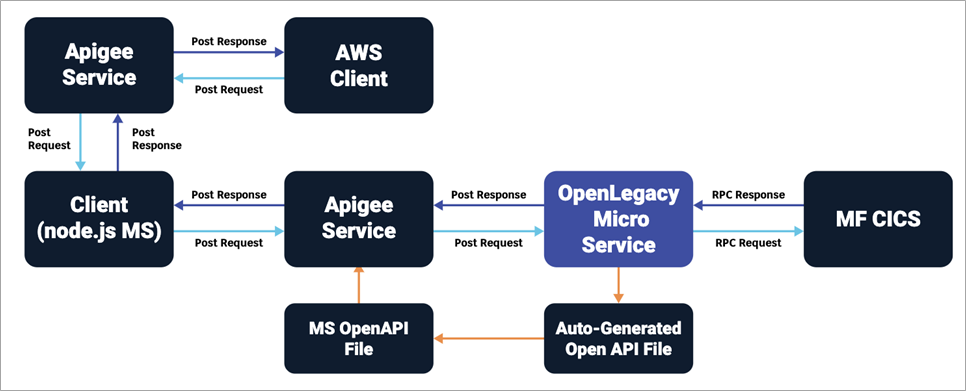
Learn all you need to know about mainframe to cloud migration: why you need it, the challenges you might face, and options for mainframe modernization.

Integrating Mainframe Workloads into Your AWS Migration and Modernization Journey with OpenLegacy
By Leigh-Ann Silver, Head of Global Alliances – OpenLegacy
Gidi Shalev, Director of Communication – OpenLegacy
Eyal Herson, VP Product Alliance – OpenLegacy
Bruno Sahinoglu and Brenesh Stanslas, Solutions Architects – AWS
Repost from original AWS post
In today’s rapidly evolving technological landscape, legacy systems like IBM Mainframe and AS400 are often a hurdle on the road to continuous innovation, flexibility, and competitiveness, while still remaining business critical.
Often built on legacy technologies, they can be challenging to maintain and integrate with modern applications, channels, and architectures. Ongoing digital transformations demand legacy applications be modernized to improve scalability and time to market, regulatory compliance, and interoperability with cloud-native applications for rapid growth.
Modernizing such systems requires specialized expertise to decouple and expose core architecture, and a carefully planned approach to minimize risks, control costs, and ensure success. In such scenarios, a hybrid modernization approach is adopted by enterprises, combining the best of legacy and modern technologies.
However, legacy monolith applications with customized architecture, together with multiple layers facilitating communication like message-oriented middleware, enterprise service bus (ESB), and REST APIs, can significantly delay the process of developing and deploying APIs.
In this post, you will learn how OpenLegacy helps enterprises untangle monolithic core systems with its integration technology to build APIs from legacy assets like mainframes and midrange systems. We’ll also detail how customers are enabled to accelerate innovation and improve customer experience and integrate with cloud-native applications in Amazon Web Services (AWS).
OpenLegacy is an AWS Partner and AWS Marketplace Seller that provides a legacy modernization and integration solution with its OpenLegacy Hub (OL Hub) platform that automates the creation of digital services from legacy systems quickly, easily, and securely.
OpenLegacy Architecture Overview
OpenLegacy Hub (OL Hub) is a cloud-native platform that bridges the gaps across legacy and modern systems using APIs and data-driven integration. It accelerates development and time-to-market with fully reusable modules, automated templates, and built-in deployment to AWS.
With OL Hub, enterprises can leapfrog the complexity of traditional middleware to rapidly create new offerings reusing their existing legacy applications with a simple solution. It works with several legacy stacks like COBOL, PL1, RPG, DB2 (for z and i), IMS, CTG, and files like VSAM, and PCML.
OpenLegacy’s native connectivity to legacy systems allows you to build user-friendly integrations automatically through the frontend interface using a no/low/full code methodology of your choice in modern languages like C#, Java, and .NET. The legacy applications don’t need to be changed for their integration.
Seamlessly integrating legacy applications with OpenLegacy Hub offers key benefits:
- Connectors for rapid integration:OpenLegacy’s broad range of connectors lets you connect legacy systems such as IBM Mainframes and IBM i (AS/400) to modern digital services such as chatbots and cloud environments and extract metadata. OL Hub has connectors for middleware, databases, environments, stored procedures, and industry-specific products like Hogan/Finastra.
- Easy-to-use interface:Enables you to expose legacy assets such as copybooks, PCML, RPG files, and VSAM records into APIs, serverless functions, and Kafka endpoints, bringing in standardization of cloud-native development to enterprises with monolithic core systems.
- Expose and unleash legacy assets or data:Do so in OL Hub without any changes to your IBM mainframe applications or IBM i systems, thereby reducing the risk to regulatory compliance or business continuity.
- SDK project creation:Decouple fine-grained business objects from complex legacy applications with no coding or changes to your mainframe applications or IBM i systems.
- One-click deployment of microservices with built-in templates and wizards, connect directly with the legacy or on-premises system, and automatically extend backend systems as independent and scalable microservices.
With this hybrid approach, OL Hub allows multiple disparate systems to coexist and collaborate in a single environment by reusing legacy assets. In addition to this, OpenLegacy can be leveraged for incremental modernization initiatives.
OpenLegacy Deployment on AWS
Customers can use OpenLegacy’s solution in the following ways:
- OpenLegacy Hub SaaS design + runtime:For clients looking for a complete fully managed legacy systems integration solution in AWS.
- OpenLegacy Hub SaaS design time only:For clients looking to develop APIs on OpenLegacy’s cloud but deploy and run them on their own environments.
- OpenLegacy Hub Enterprise edition full on-premises:For clients looking to use the solution on their own premise only.
Following is a typical architecture used by customers:

Figure 1 – OpenLegacy reference architecture on AWS.
API Generation Flow
- API developer enters the connection details to the legacy system and defines which program he wants to expose.
- OL Hub pulls the metadata of the program from the legacy system.
- Program is exposed as a microservice API or AWS Lambda function that can be deployed in AWS.
API Execution Flow
- User sends a request to Amazon API Gateway.
- Request is routed to an available microservice on the cluster.
- OpenLegacy API executes the program on the legacy system using AWS Direct Connect.
- If deployed as a Lambda function, Amazon Simple Storage Service(Amazon S3) is used for storing the Lambda code.
Customer Success: Bank Leumi
Bank Leumi, a publicly traded Global 1000 bank, is Israel’s largest bank. Founded in 1902, it has a track record of modernization programs such as open banking and mobile bank branches (on trucks) in the 1950s.
To comply with open banking regulation, Bank Leumi initiated a program that would transform it into an API-first organization by adapting its existing legacy mainframe systems. With this program, the bank wanted to shorten time-to-market (TTM) for new services, lower mainframe infrastructure costs, and support modern technologies.
Challenge
Bank Leumi laid out its challenge—to create an API factory that could automatically generate and deploy a microservice from its mainframe CICS to its on-premises Amazon EKS Anywhere cloud environment within five minutes. This would allow the bank to accelerate development and avoid the expense of using its current enterprise service bus, or introducing an additional ESB or integration layer on top of its legacy system.
Bank Leumi has a process for onboarding APIs where APIs and microservices must be accompanied by matching OpenAPI files, checked and validated by the bank’s API governance board. The API management platfrom uses these OpenAPI files to add security and validate the response and request. Preparing an OpenAPI file for each API and microservice manually from the mainframe CICS-COBOL is a complex, time-consuming, and costly operation.
Solution
The key to Bank Leumi’s success was selecting Amazon EKS Anywhere as its on-premises cloud environment, use an API management platform, and OpenLegacy to create the connectivity with the mainframe to expose the legacy resources as microservices.
OL Hub was designed to support this type of scenario, and OpenLegacy CICS Adapter was customized to the bank’s requirements with a template that’s required for the bank’s Swagger Committee’s approval process for the OpenAPI files.
The automated process would create the microservice, accompanying OpenAPI file, and then deploy the API to the bank’s cloud environments. Within five minutes, the API gateway would be fed with the production API to start sending requests.
The first test for the new solution was the development of a login microservice, which included the:
- Creation of an automation script to drive the factory.
- Identification of relevant legacy resources.
- Definition of environments.
The microservice was created and deployed automatically from end to end by the script seamlessly within the five-minute challenge.
The end-to-end solution comprises of three flows:
- At first, the OpenLegacy Hub auto-generates a microservices API-based on the approved OpenAPI specification file into the API gateway, which is responsible for managing and publishing the service.
- Second, the AWS client posts a request targeting the legacy system. The request is passed through additional logic functionality (written in node.js) and several API gateway services that are validating the conformity of the message against its OpenAPI files.
- Third, in the legacy system the request is accepted and the appropriate functionality is executed; for example, running a Cobol program that returns a response message.
This is handled by OpenLegacy Microservice, which returns the response message to the calling AWS client. The API gateway services are again utilized to check the consistency of the response message.

Figure 2 – End-to-end solution flows diagram.
Results
The entire process is streamlined with the automation capabilities of OpenLegacy Hub, which automatically generated the service and accompanying OpenAPI file. This made it immediately available to the Swagger Committee and API gateway as part of the automated script, allowing Bank Leumi to achieve significant savings, improved operations, and reduced errors.
OL Hub also enabled Bank Leumi to achieve the goal of copybook-to-service in five minutes. The smooth integration between the API gateway and OpenLegacy gave Bank Leumi confidence in its API-first paradigm.
Building on this success, Bank Leumi has set out a new challenge: to create and deploy 25 new microservices in just one week. The bank also opened its Fintech service, Finteka deployed on AWS, to external vendors and partners by providing APIs to connect with the bank.
In a period of six months, OpenLegacy with Bank Leumi prepared the infrastructure of DevOps pipeline, automation, security, and data governance to achieve the goal and deploy 25 microservices, while today new business cases are funneling in and the usage of OpenLegacy Hub keeps expanding.
Conclusion
In this post, we looked at how OpenLegacy Hub (OL Hub) helps customers with a simple, disruption-free method to generate, extend, and manage digital services from legacy systems to AWS.
Key benefits of OL Hub include:
- Speed and agility:With OpenLegacy’s automated services creation and AWS cloud infrastructure, organizations can modernize their legacy systems faster and more efficiently than traditional approaches. This means companies can bring new products and services to market faster, respond quickly to changing customer needs, and stay ahead of the competition.
- Cost savings:By leveraging AWS’s pay-as-you-go pricing model and reducing the need for custom coding and manual processes with OpenLegacy’s platform, organizations can achieve significant cost savings compared to traditional legacy re-architecting approaches. This enables businesses to invest in innovation and growth initiatives without sacrificing quality or security.
- Improved security and scalability:With AWS’s security and compliance capabilities, and OpenLegacy’s APIs and microservices integration and security templates, organizations can ensure the security and scalability of legacy systems as they move to AWS. This helps meet regulatory requirements, protect sensitive data, and ensure high levels of performance and availability.
- Better customer experiences:By modernizing legacy systems with OpenLegacy and AWS, organizations can improve the customer experience by providing faster and more reliable access to data and services, as well as developing new digital channels and capabilities that meet the evolving needs and expectations of customers. This helps companies increase customer loyalty, retention, and revenue.
Learn more about OpenLegacy on its website and in AWS Marketplace. You can also request a demo.
We’d love to give you a demo.
Please leave us your details and we'll be in touch shortly
